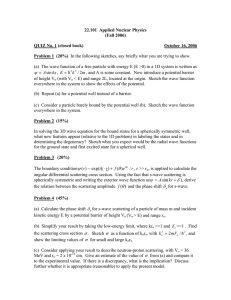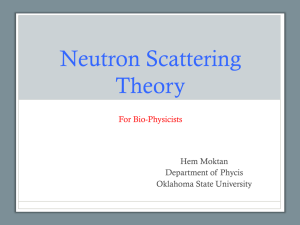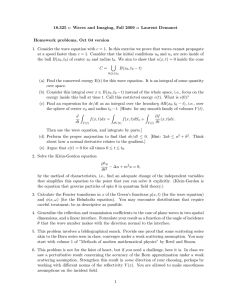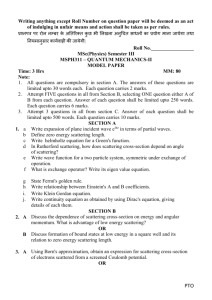Document 13614582
advertisement
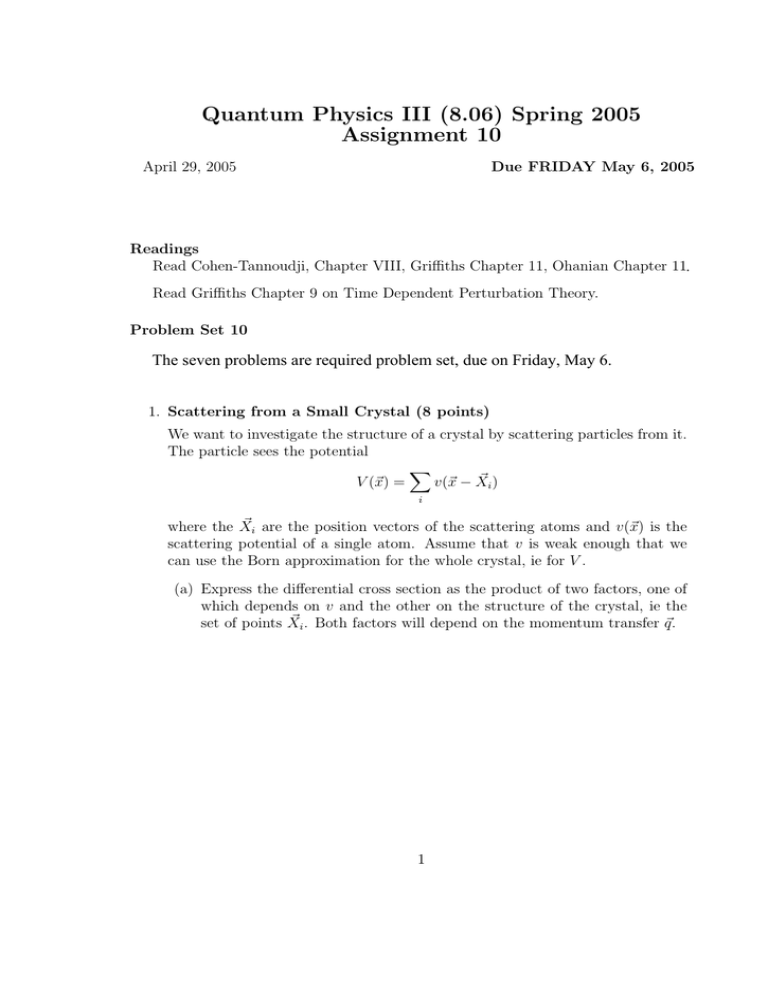
Quantum Physics III (8.06) Spring 2005 Assignment 10 April 29, 2005 Due FRIDAY May 6, 2005 Readings Read Cohen­Tannoudji, Chapter VIII, Griffiths Chapter 11, Ohanian Chapter 11. Read Griffiths Chapter 9 on Time Dependent Perturbation Theory. Problem Set 10 The seven problems are required problem set, due on Friday, May 6. 1. Scattering from a Small Crystal (8 points) We want to investigate the structure of a crystal by scattering particles from it. The particle sees the potential � � i) V (�x) = v(�x − X i � i are the position vectors of the scattering atoms and v(�x) is the where the X scattering potential of a single atom. Assume that v is weak enough that we can use the Born approximation for the whole crystal, ie for V . (a) Express the differential cross section as the product of two factors, one of which depends on v and the other on the structure of the crystal, ie the � i . Both factors will depend on the momentum transfer �q. set of points X 1 (b) Briefly, compare to whatever you know about Bragg scattering. 2. Partial Waves (10 points) Suppose the scattering amplitude for a certain reaction is given by � � 1 Γk 2iβk3 3 f (θ) = + 3e sin 2βk cos θ k k0 − k − ikΓ (1) where Γ, k0 , and β are constants � characteristic of the potential which produces the scattering. Of course k = 2mE/�2 is the deBroglie wavenumber. • What partial waves are active (i.e. what values of �)? • What are the phase shifts in the active partial waves? Do they have the proper behavior as k → 0? • What is the differential cross section, dσ/dΩ for general values of k? • What are the partial wave cross sections, σ� ? • Assume βk03 � 1. Give an approximation to the total cross section σ(k) for k ≈ k0 . • What is the total cross section for general values of k? What is the imagi­ nary part of the forward scattering amplitude? Do they satisfy the optical theorem? 3. Combining Born and Partial Waves (6 points) A potential V (r) is of the Yukawa form, VYukawa (r) = β exp(−µr) r for r > R, but is unknown for r < R. The differential cross­section dσ/dΩ has been measured as a function of energy (= �2 k 2 /2m) and angle, for values of k up to and of the order of 1/R. Attempts to fit dσ/dΩ to the partial wave formulae using a small number of phase shifts δ� (k) (i.e. putting δ� = 0 for all �’s greater than some �0 ) have been a miserable failure. [Aside: this is what actually happened when the scattering of neutrons off protons was first done at energies up to about 100 MeV. The fits to a straightforward partial wave analysis of the type just described were hopelessly ambiguous.] It is proposed that though the higher phase shifts are all small, their sum cannot be neglected. This is annoying, because we do not want to use the partial wave analysis for infinitely many values of �. In order to make progress, we make the following assumptions: 2 • Because of the centrifugal potential �2 �(�+1)/2mr2 , once � is “big enough” the behavior of V (r) for r < R does not matter, and we can therefore calculate the behavior of δ� for large � just from VYukawa (r). • These δ� can be expanded in powers of β and we can keep only the first term. That is, each of these δ� ’s is small, so we can expand it. It is the sum of all of them which is causing problems. Carry out the following procedure to implement this idea, treating � ≥ 1 as “big enough” in the sense above. (a) Write the Born approximation for the scattering amplitude fYukawa (θ, φ) for the potential VYukawa . You can get this from Problem Set 9, so this part of the problem is worth no points. (b) Calculate the mean value of fYukawa at fixed k, averaging over all directions (θ, φ), and subtract this mean value from fYukawa . [Since the s­wave scattering amplitude has nonzero mean, while all higher partial wave scattering amplitudes have zero mean, what you have just done is to subtract the s­wave part of the Born approximation to fYukawa . What remains is the sum of the contributions of all partial waves with � ≥ 1. Note that making the first Born approximation is equivalent to linearizing fYukawa in β. So, you have now accomplished most of what we set out to do.] (c) You must now add back in an expression for the s­wave contribution to f . As the s­wave is more sensitive to the small r region of the potential than any other partial wave, you cannot analyze it using the Yukawa potential. So, just add in the s­wave contribution to f written in terms of an unknown phase shift δ0 (k). Write down a formula expressing dσ/dΩ in terms of m, �, k, θ, µ, β and δ0 (k). [To complete the story, what you now do is fit the data to your formula, and thus obtain µ, β and δ0 (k). The fit to the data now works beautifully, and the fitted value of µ turns out to be the mass of the pion (times c/�) just as Yukawa had predicted 20 years before.] 4. Scattering from a δ­Shell (13 points) Consider s­wave (� = 0) scattering from the potential V (r) = λ �2 δ(r − R) 2mR with λ a large positive constant. To find the phase shift δ0 (k) we have to solve d2 u λ 2 δ(r − R)u , + k u = dr2 R 3 with u = 0 at r = 0 and u = sin(kr + δ) for r > R. (a) What is u in r < R? (b) By comparing u� (r)/u(r) just inside and just outside r = R, find a formula to determine δ. (c) Find the scattering length a, defined by limk→0 δ0 = −ka. (d) Assume λ � 1. Sketch δ(k). Show that for kR just below nπ, with n a positive integer, δ(k) increases very rapidly by π (as kR increases towards nπ). Sketch the s­wave cross­section σ0 . Show that the s­wave scattering from this potential is the same as that from a hard sphere of radius R for all values of kR except those such that kR is close to nπ. What is the significance of these values? 5. Ramsauer­Townsend Effect (6 points) At very low energies only the s­wave contributes to scattering. If, for some reason, the s­wave phase shift vanishes, then so does the scattering amplitude. Under these circumstances a projectile can pass through material without any scattering. This effect is known as the Ramsauer­Townsend Effect. Consider a three dimensional “square well”, V (r) = −V0 for r ≤ a 0 for r > a (2) (a) Find the condition on γ 2 = 2mV0 a2 /�2 such that the cross section for a particle of mass m is zero at zero energy. Your answer should be in the form of a set of values of γ 2 , specified graphically. (You need not obtain numerical values, but make sure that your graph is drawn accurately enough and labelled so that someone can use your graph to read off the first few numerical values to within 10%.) (b) As you can see from part (a), it is useful to think of the Ramsauer­ Townsend effect as a function of the depth of the potential. The existence of bound states is also a function of the depth of the potential. Show that if a square well which displays an exact Ramsauer­Townsend effect is made a little deeper or shallower (you have to figure out which) it then has a bound state at threshold. 6. Scattering in the Semiclassical Approximation (4 points) The semiclassical approximation becomes better at high energies. For most problems high energies means scattering as opposed to bound states. It is quite straightforward to estimate the phase shift in the semiclassical approximation. 4 Consider scattering in the s­wave in three dimensions. The radial wavefunction obeys 2m −u�� (k, r) + 2 V (r)u(k, r) = k 2 u(k, r) (3) � and u(k, 0) = 0. In this problem we will assume that V (r) is smooth and slowly varying and that r2 V (r) → 0 as r → ∞ and that V (r) is negative at all r. (We’ll change the last assumption in the next problem.) Recall from 8.05 (and show for yourself if you like) that as r → ∞, u(k, r) ∼ sin(kr + δ0 (k)), where δ0 (k) is the phase shift. Show that in the semiclassical approximation � � ∞ �� 2m k 2 − 2 V (r) − k δ0 (k) = dr � 0 (4) 7. A Semiclassical Analysis of Resonant Scattering (13 points) Consider s­wave scattering for a particle of mass m off a potential V (r) which vanishes at the origin, rises steadily as r increases from zero, reaches a maximum at r = c, and then goes quickly to zero as r increases further. For � = 0, the radial wave function u(r) satisfies the same Schrödinger equation as that for a particle in one dimension with potential V , subject to the boundary condition u(0) = 0. Consider scattering with energy E where 0 � E � V (c). The classical turning points are at r = a and r = b with a < c < b. (a) What is the semiclassical approximation to the wave function in the clas­ sically allowed region, 0 ≤ r < a? (b) What is the ratio of the amplitude of the wave function u(r) in the semi­ classical approximation in the region x > b compared to that in the region x < a, for generic values of E? (c) For some special values of E, there is a qualitative change in the ratio of the amplitude for x > b to the amplitude for x < a, compared to its “generic” value at other energies. What condition determines these special values of E? (d) Describe the qualitative behavior of the s­wave phase shift and s­wave cross­section for energies in the vicinity of the special values of E. 5



